
Europe and Mediterranean: Greek Isles & Turkey Cruise
Celebrity Cruises
With history spanning thousands of years, glamorous ports, and dazzling scenery, a Mediterranean cruise is an amazing vacation destination—experience the Mediterranean with Celebrity and you will see renowned ports of call in style.

Executive Member Benefit
Executive Members receive an annual 2% Reward, up to $1,250, on qualified Costco Travel purchases
Digital Costco Shop Card
Member Exclusive: Digital Costco Shop Card with every Celebrity Cruises sailing†
Sailing Itinerary

Note: Cruise itineraries are subject to change. Please verify ports and times directly with the cruise line.
Overview
Barcelona is a charming, cosmopolitan port on the shores of the Mediterranean Sea. This prosperous and bilingual (Spanish and Catalan) metropolis measures up to a city such as Madrid: its museums, theaters, art galleries, and nightlife area are of an impressively high standard. Besides that, this art and design center has a lot of interesting sights to offer to its visitors. The best place to watch people go by, stroll, or simply relax, is 'Las Ramblas', a pedestrian street with dozens of outdoor cafes. Here, you’ll find flower stands, book kiosks, and small market stalls where they sell birds and small animals. You’ll also find an endlessly fascinating flowing receptacle of pageant jugglers, singers, dancers, puppeteers, sidewalk artists, living statues, and assorted oddballs on parade. Nearby is 'Place Real', with plenty of bars and restaurants, and 'Palau Guell', built by the Catalan architectural genius Antoni Gaudi in his undulating art-nouveau style. After having seen these sights, stroll the narrow winding streets of the 'Barri Gotic', the medieval Gothic quarter full of interesting tapas bars, and cafes. Check out Picasso’s old hangout, 'Els Quatre Gats', which has been renovated without losing its bohemian charm. Or head for the old Barceloneta section on the waterfront. This working-class area, which was always slightly rundown and scruffy-looking, is now packed with paella restaurants. The new beach area, which runs from Barceloneta to the Olympic Village, is much cleaner than the old beach area. Although some people believe that it has been cleaned up considerably, it might be a wise idea to stay out of the water. Fortunately, the beach itself is already a feast for the eyes (and ears), with its huge and roaring waves.
Overview
If you've ever wondered what sort of prize you'd get for saving Europe, look no further than Valletta. Named after La Valette, the Grandmaster who masterminded Malta's successful stand against the Turkish siege of 1565, Valletta became the city of the Knights of the Order of St John and the seat of Malta's government. While traveling through the Mediterranean, Sir Walter Scott described Valletta as 'the city built by gentlemen for gentlemen'. Today it's a beautifully preserved 16th-century walled city, small enough to cover in a few hours without sweating too much in the Mediterranean sun. The streets were carefully laid out to channel cool breezes in from the harbour. Situated on the northeast coast of Malta, Valletta is the capital and is built on the promontory of Mount Sciberras which juts out into the middle of a bay. This dissects the bay into two deep harbors: the Grand Harbour to the east and the Marsamxett to the west. Valletta is a rough rectangle at the tip of a peninsula on the coast, just a few hundred meters across in either direction, and thus surrounded by water on its northern, eastern, and southern sides. The city was named after Jean Parisot de la Valette who was the Grand Master of the Order of the Knight Hospitallers (Knights of Saint John of Jerusalem). This famed religious order of hospitallers was founded in Jerusalem in the 11th century and made their base in Malta after they were expelled from Rhodes by the Ottoman Turks. During the time of Grand Master La Valette, in 1565, the Knights and the Maltese managed to suppress a siege on the island by the forces of Süleyman the Magnificent, Sultan of the Ottoman Empire in what was to become known as one of history's greatest sieges. Following the siege, the building of the city began in the same year 1565 to create a base for the defense of the island. Although Grand Master La Valette managed to lay the first stone, he died before its completion. Most of the embellishments of Valletta were done during the time of Grand Master La Cassiere, especially the magnificent St John's Co-Cathedral. The reign of the Knights of St John eventually came to an end with the successful invasion by Napoleon who occupied Malta on his way to Egypt. A Maltese revolt against the French garrison was the catalyst for the occupation of Valletta by the British in 1800. Valetta is also the spot where the Italian fleet surrendered to the Allies in 1943. Valletta's network of streets is laid out in an orthogonal grid dominated by a main artery that crosses the length of the entire city and opens up into a series of squares at its geometric center, around the Palace of the Grand Masters. The city architecture is inspired by Italian Renaissance planning principles and served as an early model of urban design. Valletta is one of the most important planned towns of the Renaissance. It equals in its noble architecture, any capital in Europe, while its timeless beauty and artistic treasures make it a well-deserved World Heritage site. There are several superb museums here as well as historical sites that are worth visiting. The main thoroughfare in the city is Republic Street. You'll find all the main shops and character-filled side streets leading off from here. For those interested in shopping, Merchant's Street and Lucia Street are the places to go for the most interesting merchandise. Lucia Street is famous for the exquisite silver and gold filigree jewelry sold there. Merchant Street specializes in souvenirs and is also home to a large open market.
Overview
Today Piraeus is the home base of Greek shipping, the largest commercial fleet in the world, apace bound to the sea like few others. The harbors of Zea and Mikrolimano as well as Phaliro play host to countless yachts and sailing craft throughout the year. Piraeus was known in medieval times as Porto Leone, a name due to the enormous stone lion, which guarded the port's entrance. Today, the life of Piraeus is centered on its three ports: the main, central one, and those of Zea and Mikrolimano. You can walk around the central harbor, shared by cargo and passenger ships alike, and watch the constant comings and goings of goods and people from around the world. Having completed your tour of the central harbor of Piraeus you will then head south traversing the peninsula and arriving at Peiraiki, one of the most picturesque neighborhoods in the city. Here one finds the harbor of Zea, one of the largest marinas in the Mediterranean. If the night finds you in the area, you can try one of the many bars found nearby. You can continue your tour along the waterfront heading towards Kastella but a small deviation toward the city center will be useful for then you can visit the verdant square of the municipal Theatre with cafeterias and shops of all kinds surrounding it. The magnificent building housing the Municipal Theatre as well as the Town Hall and the Library complete the picture presented by the main square in the city. Piraeus's little natural harbors are among its busiest and most touristy areas: Mikrolimano, Passalimani, Zea, Freatida, and Hatzikiriakio. Countless seaside tavernas provide delicious seafood washed down with the uniquely Greek drink, ouzo. The fresh smell of the sea and the sounds made by the assortment of caiques, yachts, and sailing ships, which are moored next to the tables, complete the enjoyment of the food Beyond the port, the most impressive spots are the hills of Profitis Ilias and Kastela with their neoclassical mansions and modern buildings which look as they are hanging over the sea.
Overview
Fira is a comparatively modern town, with houses built mostly during the 19th century when the old Venetian capital at Skaros became untenable due to earthquakes. The architecture is a jumble of Cycladic and Venetian, side by side, the similarities between the two being the stark whiteness. The impact of Aegean tourism has made itself felt in Fira, judging from the abundance of taverns, hotels, discotheques, and shops. It is the largest town on the island and has gained preference with travelers because it is central and access to other parts of Santorini is made easy by either taxi or bus. From there you can indulge in some inspiring coastal walks. Wandering through the white cobbled streets of Fira, a town of about 2,000 inhabitants, one gets the feel of the old-world charm blended in with the modern-day comforts. The town's archaeological museum is crammed with finds from excavations at Akrotiri. But besides being so interesting archaeologically, Santorini is essentially a beauty spot, an island whose cliffs seem to glow under an exceptionally clear light all day, but which at sunset glow redly, evoking that vast explosion more than 3000 years ago.
Overview
This seaside resort town has grown immensely in the last 30 years and is especially popular with package holiday-makers from Europe. From a population of 6000 in the 1970s, it is now closer to 50,000, although a high proportion of this is part of the tourist industry and here only for the summer. Many cruising ships traveling around the Aegean Islands stop here, especially because of its proximity (20km) to Selcuk. Kusadasi is a good base to explore this and other ancient cities like Priene and Didyma. Although there is little historical interest in Kusadasi itself, the town is popular predominantly because of its many hotels, restaurants, souvenir and carpet shops, and lively nightlife. The Kale district has some old traditional houses and narrow streets which gives some indication of what the town used to be like. The most famous beach is Kadinlar Plaji, 2.5km south of the town, dominated by huge hotels, and can get very crowded in summer. There are several small beaches further south, and closer to town is Yilanci Burnu, the peninsular.
Overview
Mykonos is world-famous. It is no coincidence that this, the most cosmopolitan of all Greek islands, attracts so many visitors from all over the globe, including large numbers of artists and intellectuals. Here, the steep mountains to be encountered in most of the Cyclades give way to low, rocky hills which combine with superb beaches to make up the landscape of the island. The capital, Hora (Chora), with its colourful harbour in which little fishingboats nestle happily side by side with luxury yachts, presents quite a different picture from the majority of Aegean island towns. While it is usual for island villages to be built on naturally amphitheatrical sites, Mykonos is spread out over a flat area and conveys an impression of lid aesthetic cohesion. Along the whitewashed streets stand brilliant white box-shaped houses with stepped walls for sitting on, wooden doors and windows and brightly-coloured balconies. These are interspersed with small but impressive churches, pretty little tavernas and shops selling souvenirs and other goods, and the overall sense is of being inside a film set. On the low Kastro hill is the complex of churches known collectively as Our Lady 'Paraportiani', a superb arrangement of whitewashed masses created over the centuries and now recognised as a national cultural monument. Of particular historical and aesthetic interest are the medieval houses in this district of the town, which stand like a wall above the sea protecting the west side of Hora. The Archaeological Museum of Hora contains finds from tombs on the nearby island of Rhenia, sculptures, vases and figurines. The Folklore Museum brings together a number of collections of furniture, icons, pieces of sculpture and folk musical instruments. Mykonos is also the home of the Nautical Museum of the Aegean, which has interest all of its own. The countryside of Mykonos is a mixture of grey-green rocks ringed by prickly pear plants and little fertile areas carpeted with wild flowers. Here and there are tiny whitewashed chapels and windmills. Ano Mera is, after Hora, the most important of the older villages on the island. Standing 8 km. to the east of the town, Ano Mera has the interesting monastery of Our Lady Tourliani, ornamented with fine wood-carvings. The church has a collection of valuable ecclesiastical vessels, vestments and embroideries. The courtyard contains an interesting bell-tower and a marble fountain. Here lovers of the sea will find outstanding golden beaches such as Agios Stefanos, Psarou, Kalafatis, Platis Gialos, Ornos, Elia and Panormos. Miykonos is a busy island with all the amenities of a modern resort and with plenty to do - by day or night for those who want to have a lively time. Yet visitors fond of more peaceful holidays will still find quiet corners in which to relax.
Overview
Almost 25km. Ancient Olympia is located in the medieval Katakolo, in the district of ancient Pheia, which is, known today as the port of Pirgos, the capital of our prefecture. Katakolo is a small town, with many shops, bars, and good fish taverns, with fresh and tasty fish. The bay of Agios Andreas is located next to Katakolo, on the top of a hill, and the ruins of Pontikokastro, a very strong fort in the past, the period of Villehardouins. At Agios Andreas, everyone can enjoy coffee or a drink, admiring the sea and the gorgeous sunset.
Overview
Located about 80 kilometers northwest of Rome, the Port of Civitavecchia is the port of Rome and a busy ferry and cargo port serving Italy and southern Europe. Lying on Italy’s eastern shores on the Tyrrhenian Sea, the Port of Civitavecchia has excellent direct connections to Rome. It is an important cruise and ferry port with regular passage to Sardinia, Malta, Sicily, Tunis, and Barcelona. Fishing is of secondary importance to the Port of Civitavecchia. In addition to ocean-going traffic, the Port of Civitavecchia also contains a thermoelectric center and metallurgical works. In 2006, over 51 thousand people called the Port of Civitavecchia home. The Port of Civitavecchia was built on an earlier Etruscan settlement. Emperor Trajan founded the Port of Civitavecchia in the early 2nd Century, calling it Centumcellae. Today, Trajan’s Port is preserved within today’s Port of Civitavecchia. A busy growing town during the late Roman era, the Port of Civitavecchia was attacked by Vandals and then destroyed by the Saracens in 828 AD. Residents escaped to the nearby Allumiere Mountains where Pope Leo IV built a walled town in 854. Eventually, the people returned to Civitavecchia (the name means “old city”). At the end of the 15th Century, the Port of Civitavecchia was under frequent attack by pirates. The naval arsenal was constructed in 1508. Pope Paul III commissioned the building of the keep, which was designed by Donato Bramante and then finished by Michelangelo in 1537, to protect the Port of Civitavecchia from pirate attacks. In 1696, Civitavecchia became a free port under Pope Innocent XII. Because it was Rome’s main port, the French occupied the Port of Civitavecchia in 1849. The Port of Civitavecchia was linked to Rome by the Rome and Civitavecchia Rail Road in 1859. When the Port of Civitavecchia became part of the Kingdom of Italy in 1870, it was one of the Papal State’s most strongly fortified towns when Papal troops welcomed General Nino Bixio on behalf of the Italian unification forces into the Port of Civitavecchia fortress. World War II brought destruction to as much as three-quarters of the Port of Civitavecchia. Reconstruction enlarged the Port of Civitavecchia beyond its pre-war area. The Authority Portuale Civitavecchia (Port of Rome) is responsible for managing and operating the Port of Civitavecchia as well as the ports of Fiumicino and Gaeta. The modern Port of Civitavecchia is at the center of rail, road, and air networks that link it with central Italy and the world. The Port of Civitavecchia can handle about 11 million tons of cargo per year and over 1.5 million passengers. Cargoes include forest products, cereals, iron and steel, chemicals, automobiles, containers, and liquid bulk. In 2007, the Port of Civitavecchia welcomed 856 cruise vessels carrying 1.6 million passengers, and the total number of passengers using ferries and cruise vessels was 3.8 million. In 2007, the Port of Civitavecchia handled a total of 7.7 million tons of cargo. This total included 1.5 million tons of liquid bulk, 1.7 million tons of solid bulk, 4.6 million tons of packages, and 31.1 thousand TEUs of containerized cargo. The Port of Civitavecchia contains 28 berths of a total of 5.6 thousand meters in length alongside depths from 6 to 18 meters. Port properties include five warehouses containing 36 thousand square meters for handling and storing cargo. The intermodal terminal includes seven thousand square meters of storage space and 12.5 thousand square meters for loading/unloading rail cars and parking. The Port of Civitavecchia is one of the busiest ferry ports in the world. Just 80 kilometers northwest of Rome, it is the main tourist destination for people traveling to the Eternal City. It is also a central port for ferries carrying passengers to more local destinations. The ferry terminal offers a complete line of amenities. Different ferry companies offer services to various destinations. Moby Lines handles crossings to Olbia, Sardinia. Corsica Sardinia Ferries runs services to Golfo Aranci. Grimaldi Ferries carries passengers to Barcelona and Tunis, and Grand Navi Veloci operates a route to Tunis. Ferrovie dello Stato operates a combined rail-ferry service to Golfo Aranci.
Onboard the Celebrity Equinox
Celebrity Equinox
Year Built: 2009
Year Refurbished: 2019
Double Occupancy Capacity: 2880
As part of Celebrity's fleet-wide modernization program, Celebrity Equinox® is now making even more waves in the cruise world. Experience brand new staterooms and elevating design concepts and technology across the ship. Marvel at completely new bathroom modernizations. Wine and dine in reimagined restaurants and lounges. It's a whole new way to experience true modern luxury while sailing to the world's most incredible destinations aboard Celebrity Equinox®.
Activities & Services (included in cruise)
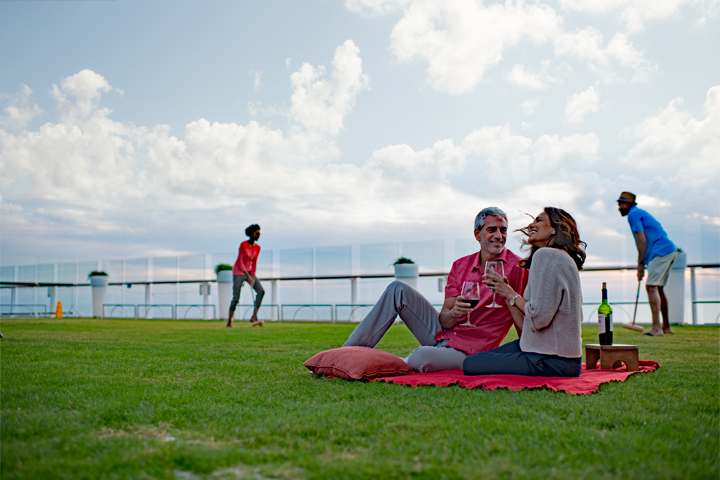
Lawn Club
- Casino
- Disco/Nightclub
- Game Arcade
- Movies
- Theater/Show Lounge
- Fitness Center
- Sauna/Steam Room
- Pool - Outdoor
- Sports Facilities
- Whirlpool/Jacuzzi
- Bars/Lounges
- Library
- Children's Indoor Play Area
- Organized Age Specific Activities
- Teen Center or Disco
- Teen Programs
- Business Center
- Concierge Desk
- Conference Center
- Duty-Free Shops/Boutiques
- Elevators
- Safe Deposit Boxes
Activities & Services (available for an extra fee)
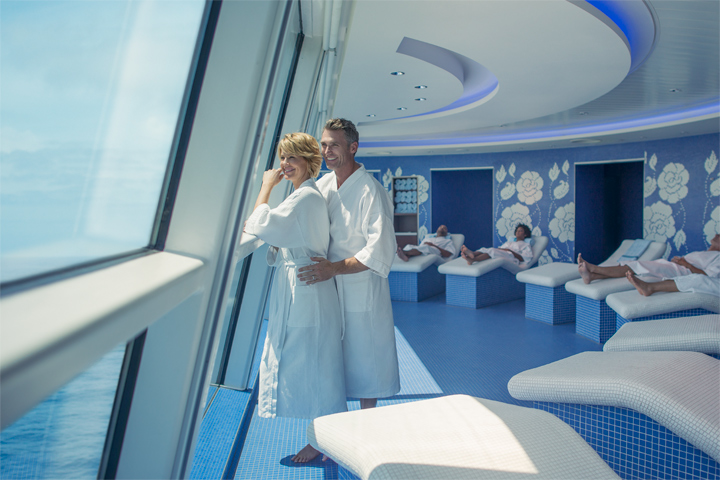
Spa
- Beauty Salon
- Full-Service Spa
- Internet Center
- Babysitting
- Dry Cleaning/ Laundry Service
- Infirmary/Medical Center
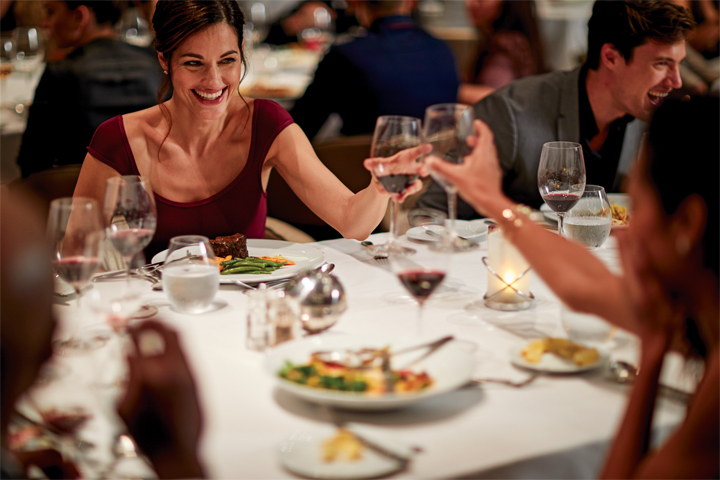
Main Dining Room
Main Dining
Main Restaurant: Impeccable service, classic design, world-class cuisine and comfortable sophistication are celebrated here. Experience tableside lobster presentation, an expansive selection of artisanal cheeses from around the world, or the extensive American and French wine list. Charming and timeless, Murano transports you, through palate and décor, to a modern and refined level of dining. Complimentary for all guests.
Blu: Available exclusively to AquaClass® guests, Blu specializes in the concept of “clean cuisine.” Popular dishes are prepared in imaginative and flavorful ways, without fussiness or pretense. Blu is open for breakfast and dinner. No charge for Aqua Class guests.
Luminae: Offering complimentary breakfast, lunch and dinner. Luminae is a culinary experience that spotlights modern, eclectic cuisine and globally inspired dishes. Luminae offers a deliciously unique dining experience exclusively for Suite Class guests. No charge for Suite guests.
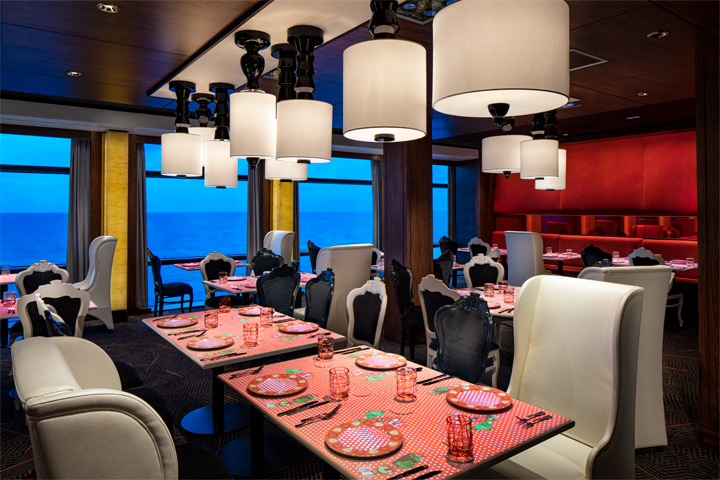
Qsine
Specialty Dining
Sushi on Five: Sushi on Five satisfies your craving for locally sourced, authentically prepared sushi and other Japanese specialties from a menu crafted by expert restaurateur and sushi chef, Yoshikazu "Yoshi" Okada. Treat yourself to the complex flavors of a hand-made sushi roll or nigiri featuring tuna albacore, shrimp, eel, and other fresh selections, or savor the simplicity of yellowtail, salmon, and octopus sashimi. Your culinary experience would be incomplete without dessert—be sure to try the caramelized gingerbread with wasabi gelato. This restaurant is available for an additional cost.
Murano: Impeccable service, classic design, world-class cuisine and comfortable sophistication are celebrated here. Experience tableside lobster presentation, an expansive selection of artisanal cheeses from around the world, or the extensive American and French wine list. Charming and timeless, Murano transports you, through palate and décor, to a modern and refined level of dining. This restaurant is available for an additional cost.
Le Petit Chef™ at Qsine: The world-renown artists of Skullmapping ™, presented by TableMation™ have reached a true pinnacle of their custom 3D table animation art form. This dining experience is beautifully choreographed with an elegant menu created by Celebrity's Michelin Star Chef. Le Petit Chef ™ offered on Celebrity Cruises is a one-of-a-kind dining concept. Available for an additional cost.
Tuscan Grill: An outgoing wait staff ensures tableside service that's personal as well as professional. And the food? Take the traditional style and artisanal flair of Italy, add contemporary influences, and serve the cuisine in abundance. It's all part of the expansive character of Tuscan Grille. This restaurant is available for an additional cost.
Café al Bacio and Gelateria: The warm atmosphere, comfortable furniture and the sweet scent of the Gelateria's freshly baked waffle cones create an instant emotional connection. Café al Bacio is a great place to relax, any time of day. Many guests like to stop by in the evening for one of the specialty dessert cocktails, and chat about a great meal that they had or a wonderful show they just enjoyed. There's always something to talk about at Café al Bacio. This restaurant is available for an additional cost.
Craft Social: The casual atmosphere of a pub, elevated. Comfort food and craft beer enthusiasts rejoice. Craft Social offers over 40 handcrafted boutique beer selections, creative cocktails and a wide selection of a la carte, gourmet comfort food and bar bites that are so satisfying you could make a meal of them. If you prefer wine with your eats, Celebrity's wine list presents an impressive selection by the glass or bottle. With inviting entertainment and great music, Craft Social offers an atmosphere of casual sophistication. Available for an additional cost.

Sunset Bar
Casual Dining
The Spa Cafe: Celebrity has created an extension of its leading spa experience by introducing The Spa Cafe, one of the first venues of its kind in the cruise industry. The result is a creative take on healthy cuisine, featuring an eclectic blend of offerings that are both flavorful and nutritious. Complimentary for all guests.
Pool/Mast Grill: Let your cravings go wild. Grab a great burger in a relaxed, poolside environment. Complimentary for all guests.
Oceanview Café: A market-style cafe that features select offerings inspired by the destinations you visit. Complimentary for all guests.
Room Service: Perhaps a day of kayaking, shopping or golfing has you feeling pleasantly languid-or was it the afternoon spent relaxing with a novel that has you so serene? Either way, when you're in the mood to relax and dine in the comfort of your stateroom, Celebrity offers complimentary 24-hour in-stateroom dining.
Elegant staterooms feature an ample sitting area with a sofa and a flat screen TV.
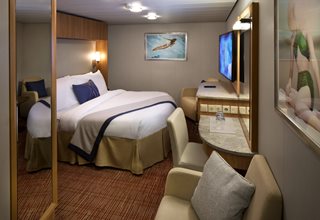
Category: I2
The private and perfectly proportioned Inside Stateroom is the ideal place to relax after your day of discovery. Need a little extra space? Combine two Inside Staterooms. Connecting at sea has never been easier.
181 sq.ft
Amenities:- Four pillows in every stateroom
- Plush 100% cotton bathrobes and towels
- Premium Custom blended bathroom products
- Celebrity shopping bag
Stateroom Features
- Celebrity's eXhale® bedding featuring the Cashmere Mattress
- King-sized bed**
- Some staterooms may have a trundle bed
- Plentiful storage space in your bathroom and wardrobe
- Interactive television system
- Individual safe
- Dual-voltage 110/220V AC
- Mini-fridge*
- Hair dryer
Services
- Twice daily housekeeping service
- Our signature friendly personalized service with a guest ratio of nearly 2:1
- Laundry service*
- Complimentary beach towel service
- Fresh ice delivered to stateroom upon request
Dining
- Complimentary breakfast, lunch, and dinner in a variety of restaurants
- 24-hour room service†
** Bed as large or larger than average standard international king-size bed
† $9.95 service fee and 20% gratuity may apply

Category: I1
The private and perfectly proportioned Inside Stateroom is the ideal place to relax after your day of discovery. Need a little extra space? Combine two Inside Staterooms. Connecting at sea has never been easier.
181 sq.ft
Amenities:- Four pillows in every stateroom
- Plush 100% cotton bathrobes and towels
- Premium Custom blended bathroom products
- Celebrity shopping bag
Stateroom Features
- Celebrity's eXhale® bedding featuring the Cashmere Mattress
- King-sized bed**
- Some staterooms may have a trundle bed
- Plentiful storage space in your bathroom and wardrobe
- Interactive television system
- Individual safe
- Dual-voltage 110/220V AC
- Mini-fridge*
- Hair dryer
Services
- Twice daily housekeeping service
- Our signature friendly personalized service with a guest ratio of nearly 2:1
- Laundry service*
- Complimentary beach towel service
- Fresh ice delivered to stateroom upon request
Dining
- Complimentary breakfast, lunch, and dinner in a variety of restaurants
- 24-hour room service†
** Bed as large or larger than average standard international king-size bed
† $9.95 service fee and 20% gratuity may apply

Category: Z
This category can be booked for a special rate, guaranteed to you. Please note that the category is not associated at the time of booking with a specific stateroom, deck, bedding configuration or other particular settings. The assignment of an actual cabin will be performed during your check-in. The cabin can be anywhere on the ship.
Enjoy a view of the sea with spacious staterooms that feature a sofa and a flat screen TV.
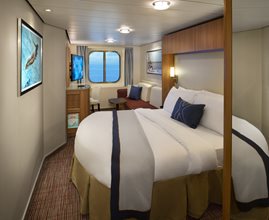
Category: O2
Each ocean view stateroom on board Celebrity includes the following world-class amenities that all contribute to your modern experience.
Amenities:- Plush 100% cotton bathrobes and towels
- Four pillows in every stateroom
- Premium Custom blended bathroom products
- Celebrity shopping bag
Stateroom Features
- Expansive view of the ocean
- Celebrity's eXhale® bedding featuring the Cashmere Mattress
- King-sized mattress**
- Some staterooms may have a trundle bed
- Plentiful storage space in your bathroom and wardrobe
- Interactive television system
- Individual safe
- Dual-voltage 110/220V AC
- Mini-fridge*
- Hair dryer
Services
- Twice daily housekeeping service
- Our signature friendly personalized service with a guest ratio of nearly 2:1
- Laundry service*
- Complimentary beach towel service
- Fresh ice delivered to stateroom upon request
Dining
- Complimentary breakfast, lunch, and dinner in a variety of restaurants
- 24-hour room service†
** Bed as large or larger than average standard international king-size bed
† $9.95 service fee and 20% gratuity may apply

Category: O1
Each ocean view stateroom on board Celebrity includes the following world-class amenities that all contribute to your modern experience.
Amenities:- Plush 100% cotton bathrobes and towels
- Four pillows in every stateroom
- Premium Custom blended bathroom products
- Celebrity shopping bag
Stateroom Features
- Expansive view of the ocean
- Celebrity's eXhale® bedding featuring the Cashmere Mattress
- King-sized mattress**
- Some staterooms may have a trundle bed
- Plentiful storage space in your bathroom and wardrobe
- Interactive television system
- Individual safe
- Dual-voltage 110/220V AC
- Mini-fridge*
- Hair dryer
Services
- Twice daily housekeeping service
- Our signature friendly personalized service with a guest ratio of nearly 2:1
- Laundry service*
- Complimentary beach towel service
- Fresh ice delivered to stateroom upon request
Dining
- Complimentary breakfast, lunch, and dinner in a variety of restaurants
- 24-hour room service†
** Bed as large or larger than average standard international king-size bed
† $9.95 service fee and 20% gratuity may apply

Category: Y
This category can be booked for a special rate, guaranteed to you. Please note that the category is not associated at the time of booking with a specific stateroom, deck, bedding configuration or other particular settings. The assignment of an actual cabin will be performed during your check-in. The cabin can be anywhere on the ship.
Staterooms feature a spacious balcony. Select categories include AquaClass® or Concierge Class.
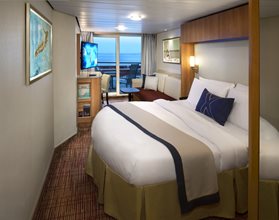
Category: V3
Amenities- Plush 100% cotton bathrobes and towels
- Four pillows in every stateroom
- Premium Custom blended bathroom products
- Celebrity Shopping bag
Stateroom Features
- Private veranda opens up to outdoor seating
- Floor-to-ceiling windows and glass doors.
- King-sized mattress** (Single Infinite Veranda has Queen-size bed)
- Celebrity eXhale® bedding
- Plentiful storage space in your bathroom and wardrobe
- In-room Automation on Edge Series
- Some staterooms may have a trundle bed
- Interactive television system
- Mini-fridge*
- Individual safe
- Dual-voltage 110/220V AC
- Hair dryer
Services
- Twice daily housekeeping service
- Our signature friendly, personalized service with a guest to staff ratio of nearly 2:1
- Laundry service*
- Complimentary beach towel service
- Fresh ice delivered to stateroom upon request
Dining
- Complimentary breakfast, lunch, and dinner available in a variety of restaurants
- 24-hour room service†
** Bed as large or larger than average standard international king-size bed
† $9.95 service fee and 20% gratuity may apply

Category: V2
Amenities- Plush 100% cotton bathrobes and towels
- Four pillows in every stateroom
- Premium Custom blended bathroom products
- Celebrity Shopping bag
Stateroom Features
- Private veranda opens up to outdoor seating
- Floor-to-ceiling windows and glass doors.
- King-sized mattress** (Single Infinite Veranda has Queen-size bed)
- Celebrity eXhale® bedding
- Plentiful storage space in your bathroom and wardrobe
- In-room Automation on Edge Series
- Some staterooms may have a trundle bed
- Interactive television system
- Mini-fridge*
- Individual safe
- Dual-voltage 110/220V AC
- Hair dryer
Services
- Twice daily housekeeping service
- Our signature friendly, personalized service with a guest to staff ratio of nearly 2:1
- Laundry service*
- Complimentary beach towel service
- Fresh ice delivered to stateroom upon request
Dining
- Complimentary breakfast, lunch, and dinner available in a variety of restaurants
- 24-hour room service†
** Bed as large or larger than average standard international king-size bed
† $9.95 service fee and 20% gratuity may apply

Category: V1
Amenities- Plush 100% cotton bathrobes and towels
- Four pillows in every stateroom
- Premium Custom blended bathroom products
- Celebrity Shopping bag
Stateroom Features
- Private veranda opens up to outdoor seating
- Floor-to-ceiling windows and glass doors.
- King-sized mattress** (Single Infinite Veranda has Queen-size bed)
- Celebrity eXhale® bedding
- Plentiful storage space in your bathroom and wardrobe
- In-room Automation on Edge Series
- Some staterooms may have a trundle bed
- Interactive television system
- Mini-fridge*
- Individual safe
- Dual-voltage 110/220V AC
- Hair dryer
Services
- Twice daily housekeeping service
- Our signature friendly, personalized service with a guest to staff ratio of nearly 2:1
- Laundry service*
- Complimentary beach towel service
- Fresh ice delivered to stateroom upon request
Dining
- Complimentary breakfast, lunch, and dinner available in a variety of restaurants
- 24-hour room service†
** Bed as large or larger than average standard international king-size bed
† $9.95 service fee and 20% gratuity may apply

Category: DV
Amenities- Plush 100% cotton bathrobes and towels
- Four pillows in every stateroom
- Premium Custom blended bathroom products
- Celebrity Shopping bag
Stateroom Features
- Private veranda opens up to outdoor seating
- Floor-to-ceiling windows and glass doors.
- King-sized mattress** (Single Infinite Veranda has Queen-size bed)
- Celebrity eXhale® bedding
- Plentiful storage space in your bathroom and wardrobe
- In-room Automation on Edge Series
- Some staterooms may have a trundle bed
- Interactive television system
- Mini-fridge*
- Individual safe
- Dual-voltage 110/220V AC
- Hair dryer
Services
- Twice daily housekeeping service
- Our signature friendly, personalized service with a guest to staff ratio of nearly 2:1
- Laundry service*
- Complimentary beach towel service
- Fresh ice delivered to stateroom upon request
Dining
- Complimentary breakfast, lunch, and dinner available in a variety of restaurants
- 24-hour room service†
** Bed as large or larger than average standard international king-size bed
† $9.95 service fee and 20% gratuity may apply

Category: SV
Your personal veranda lets you greet the day, enjoy fresh sea breezes, and soak in breathtaking sunsets.
Amenities:- Plush 100% cotton bathrobes and towels
- Four pillows in every stateroom
- Premium Custom blended bathroom products
- Celebrity Shopping bag
Stateroom Features
- Private veranda opens up to outdoor seating
- Floor-to-ceiling windows and glass doors
- King-sized mattress** (Single Infinite Veranda has Queen-size bed)
- Celebrity eXhale® bedding
- Plentiful storage space in your bathroom and wardrobe
- In-room Automation on Edge Series
- Some staterooms may have a trundle bed
- Interactive television system
- Mini-fridge*
- Individual safe
- Dual-voltage 110/220V AC
- Hair dryer
Services
- Twice daily housekeeping service
- Our signature friendly, personalized service with a guest to staff ratio of nearly 2:1
- Laundry service*
- Complimentary beach towel service
- Fresh ice delivered to stateroom upon request
Dining
- Complimentary breakfast, lunch, and dinner available in a variety of restaurants
- 24-hour room service†
** Bed as large or larger than average standard international king-size bed
† $9.95 service fee and 20% gratuity may apply
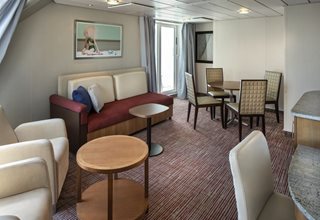
Category: UV
By far the largest stateroom with a veranda - plenty of room for you and the family.
Amenities:- Plush 100% cotton bathrobes and towels
- Four pillows in every stateroom
- Premium Custom blended bathroom products
- Celebrity Shopping bag
Stateroom Features
- Private veranda opens up to outdoor seating
- Floor-to-ceiling windows and glass doors.
- King-sized mattress** (Single Infinite Veranda has Queen-size bed)
- Celebrity eXhale® bedding
- Plentiful storage space in your bathroom and wardrobe
- In-room Automation on Edge Series
- Some staterooms may have a trundle bed
- Interactive television system
- Mini-fridge*
- Individual safe
- Dual-voltage 110/220V AC
- Hair dryer
Services
- Twice daily housekeeping service
- Our signature friendly, personalized service with a guest to staff ratio of nearly 2:1
- Laundry service*
- Complimentary beach towel service
- Fresh ice delivered to stateroom upon request
Dining
- Complimentary breakfast, lunch, and dinner available in a variety of restaurants
- 24-hour room service†
** Bed as large or larger than average standard international king-size bed
† $9.95 service fee and 20% gratuity may apply
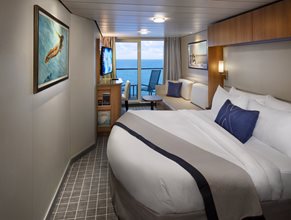
Category: C2
Amenities- Exclusive Welcome Aboard Concierge Class Lunch
- 1 bottle of Sparkling Wine per cruise upon request
- Daily delectable delights
- Pillow selection upon request
- Use of umbrella and binoculars
- Celebrity embossed key holder
Stateroom Features
- King-sized bed**
- eXhale® bedding
- Floor-to-ceiling sliding glass doors
- Sitting area with sofa
- Veranda with lounge seating
- Individual safe
- Dual-voltage 110/220V AC
- Mini-fridge*
- Hair dryer
Services
- Personalized Concierge service
- Exclusive Destination Seminar
- Laundry service*
- Complimentary shoeshine service
Dining
- Main and specialty restaurant seating time preference upon availability
- Exclusive Welcome Aboard Lunch on boarding day in the main dining room. Choose the earliest check-in times so you don't miss your welcome aboard Concierge Class lunch. (Welcome lunch times may vary by ship and itinerary.)
- 24-hour room service†
** Bed as large or larger than average standard international king-size bed † $9.95 service fee and 20% gratuity may apply

Category: C1
Amenities- Exclusive Welcome Aboard Concierge Class Lunch
- 1 bottle of Sparkling Wine per cruise upon request
- Daily delectable delights
- Pillow selection upon request
- Use of umbrella and binoculars
- Celebrity embossed key holder
Stateroom Features
- King-sized bed**
- eXhale® bedding
- Floor-to-ceiling sliding glass doors
- Sitting area with sofa
- Veranda with lounge seating
- Individual safe
- Dual-voltage 110/220V AC
- Mini-fridge*
- Hair dryer
Services
- Personalized Concierge service
- Exclusive Destination Seminar
- Laundry service*
- Complimentary shoeshine service
Dining
- Main and specialty restaurant seating time preference upon availability
- Exclusive Welcome Aboard Lunch on boarding day in the main dining room. Choose the earliest check-in times so you don't miss your welcome aboard Concierge Class lunch. (Welcome lunch times may vary by ship and itinerary.)
- 24-hour room service†
** Bed as large or larger than average standard international king-size bed † $9.95 service fee and 20% gratuity may apply

Category: SC
Amenities- Exclusive Welcome Aboard Concierge Class Lunch
- 1 bottle of Sparkling Wine per cruise upon request
- Daily delectable delights
- Pillow selection upon request
- Use of umbrella and binoculars
- Celebrity embossed key holder
Stateroom Features
- King-sized bed**
- eXhale® bedding
- Floor-to-ceiling sliding glass doors
- Sitting area with sofa
- Veranda with lounge seating
- Individual safe
- Dual-voltage 110/220V AC
- Mini-fridge*
- Hair dryer
Services
- Personalized Concierge service
- Exclusive Destination Seminar
- Laundry service*
- Complimentary shoeshine service
Dining
- Main and specialty restaurant seating time preference upon availability
- Exclusive Welcome Aboard Lunch on boarding day in the main dining room. Choose the earliest check-in times so you don't miss your welcome aboard Concierge Class lunch. (Welcome lunch times may vary by ship and itinerary.)
- 24-hour room service†
** Bed as large or larger than average standard international king-size bed † $9.95 service fee and 20% gratuity may apply

Category: A1
Spa Benefits- Unlimited access to the Adults-Only Sea Thermal Suite
- Dedicated Spa Concierge: Personal Consultation
- Priority Spa Reservations
- Complimentary fitness classes (Offering varies by cruise length. Learn more)
- Exclusive spa treatment package discounts*
- 2 Bottled waters in-room: daily
- 2 Yoga mats
- In-room fitness amenities menu
- Eco-friendly natural ingredients shower amenities
- 100% Cotton bathrobes, slippers, towels
- Welcome bottle of sparkling wine (upon request)
- Complimentary use of umbrella and binoculars
- Complimentary shoeshine service
- Pillow selection upon request
Dining
- AquaClass Exclusive Restaurant: Blu
- Expanded room service breakfast menu available†
AquaClass Features
- Floor-to-ceiling sliding-glass doors
- King-sized bed**
- Exclusive eXhale® bedding
- Plentiful storage space
- Spacious sitting area with sofa
- Enhanced air filtration system
† $9.95 service fee and 20% gratuity may apply
** Bed as large or larger than average standard international king-size bed

Category: A2
Spa Benefits- Unlimited access to the Adults-Only Sea Thermal Suite
- Dedicated Spa Concierge: Personal Consultation
- Priority Spa Reservations
- Complimentary fitness classes (Offering varies by cruise length. Learn more)
- Exclusive spa treatment package discounts*
- 2 Bottled waters in-room: daily
- 2 Yoga mats
- In-room fitness amenities menu
- Eco-friendly natural ingredients shower amenities
- 100% Cotton bathrobes, slippers, towels
- Welcome bottle of sparkling wine (upon request)
- Complimentary use of umbrella and binoculars
- Complimentary shoeshine service
- Pillow selection upon request
Dining
- AquaClass Exclusive Restaurant: Blu
- Expanded room service breakfast menu available†
AquaClass Features
- Floor-to-ceiling sliding-glass doors
- King-sized bed**
- Exclusive eXhale® bedding
- Plentiful storage space
- Spacious sitting area with sofa
- Enhanced air filtration system
† $9.95 service fee and 20% gratuity may apply
** Bed as large or larger than average standard international king-size bed

Category: XC
This category can be booked for a special rate, guaranteed to you. Please note that the category is not associated at the time of booking with a specific stateroom, deck, bedding configuration or other particular settings. The assignment of an actual cabin will be performed during your check-in. The cabin can be anywhere on the ship.

Category: XA
This category can be booked for a special rate, guaranteed to you. Please note that the category is not associated at the time of booking with a specific stateroom, deck, bedding configuration or other particular settings. The assignment of an actual cabin will be performed during your check-in. The cabin can be anywhere on the ship.

Category: X
This category can be booked for a special rate, guaranteed to you. Please note that the category is not associated at the time of booking with a specific stateroom, deck, bedding configuration or other particular settings. The assignment of an actual cabin will be performed during your check-in. The cabin can be anywhere on the ship.
Suites feature European-style butler services, priority check-in and debarkation, seating preferences and much more.
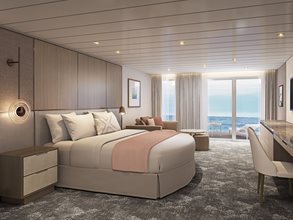
Category: S1
Perfectly designed Sky Suites offer a blend of expansive views and intimate luxury. These large suites feature our signature Cashmere™ Mattress with eXhale® bedding and a spacious, private veranda.- Studio
- 1 bathroom
- 254-362 sq.ft interior / 57-102 sq.ft terrace
Highlights
- Veranda with lounge seating
- Floor-to-ceiling sliding-glass doors
- Exclusive eXhale® bedding
- King-sized mattress*
- Trundle bed in some suites
- Plentiful storage space
- Spacious sitting area with sofa
Exclusive services and amenities
- Contact your butler wherever you are with Butler Chat
- Destination Experience Specialist to assist with your excursions
- Suite-to-car escort by your butler for Private Journeys
- Shore excursion departure lounge just for suite guests
- Premium Celebrity bath amenities
- Updated Luminae menu with new Daniel Boulud signature dishes
- Complimentary stocked minibar

Category: SS
Perfectly designed Sky Suites offer a blend of expansive views and intimate luxury. These large suites feature our signature Cashmere™ Mattress with eXhale® bedding and a spacious, private veranda.- Studio
- 1 bathroom
- 254-362 sq.ft interior / 57-102 sq.ft terrace
Highlights
- Veranda with lounge seating
- Floor-to-ceiling sliding-glass doors
- Exclusive eXhale® bedding
- King-sized mattress*
- Trundle bed in some suites
- Plentiful storage space
- Spacious sitting area with sofa
Exclusive services and amenities
- Contact your butler wherever you are with Butler Chat
- Destination Experience Specialist to assist with your excursions
- Suite-to-car escort by your butler for Private Journeys
- Shore excursion departure lounge just for suite guests
- Premium Celebrity bath amenities
- Updated Luminae menu with new Daniel Boulud signature dishes
- Complimentary stocked minibar

Category: AS
Wellness is so fundamental to our philosophy, we've created a whole new way to nourish your mind and body. Aqua Sky Suites combine the best of our rejuvenating AquaClass® experience with the ultimate luxury of The Retreat®. These suites feature a king-sized** bed with exclusive eXhale® bedding and a spacious, private veranda. Spa-inspired elements are thoughtfully infused throughout, including eco-friendly bathroom products, yoga mats, in-stateroom fitness amenities, and daily bottled water service.- Studio
- 1 bathroom
- 254-319 sq.ft interior / 57-79 sq.ft veranda
Highlights
- Spacious veranda
- Floor-to-ceiling sliding-glass doors
- King-sized bed**
- Exclusive eXhale® bedding
- Plentiful storage space
- Spacious sitting area with sofa
- Suite Automation (Available on Edge Series)
Exclusive services and amenities
- Contact your butler wherever you are with Butler Chat
- Destination Experience Specialist to assist with your excursions
- Suite-to-car escort by your butler for Private Journeys
- Shore excursion departure lounge just for suite guests
- Premium Celebrity bath amenities
- Updated Luminae menu with new Daniel Boulud signature dishes
- Complimentary stocked minibar
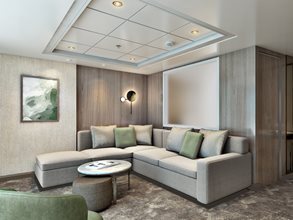
Category: CS
It's time you got the celebrity treatment. These two-room suites feature a large living area with floor to ceiling panoramic windows, private veranda, and a primary bedroom with a king-size bed featuring our signature eXhale® bedding and Cashmere™ Mattress- 1 bedroom
- 1 bathroom
- 394-498 sq.ft interior / 51-105 sq.ft terrace
Highlights
- Veranda with lounge seating
- Floor-to-ceiling sliding-glass doors
- Exclusive eXhale® bedding
- King-sized mattress*
- Trundle bed in some suites
- Plentiful storage space
- Spacious sitting area with sofa
Exclusive services and amenities
- Contact your butler wherever you are with Butler Chat
- Destination Experience Specialist to assist with your excursions
- Suite-to-car escort by your butler for Private Journeys
- Shore excursion departure lounge just for suite guests
- Premium Celebrity bath amenities
- Updated Luminae menu with new Daniel Boulud signature dishes
- Complimentary stocked minibar
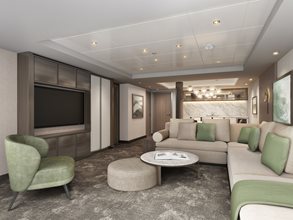
Category: RS
Unwind in a luxuriously large living area featuring floor to ceiling panoramic windows. The Royal Suite features our Cashmere™ Mattress, a primary bathroom with a large soaking tub, a separate shower, a double sink vanity, and a spacious private veranda. No matter where you are in this suite, you'll enjoy stunning views of the sea, the way every royal should.- 1 bedroom
- 1 bathroom
- 562-687 sq.ft interior / 72-195 sq.ft terrace
Highlights
- Floor-to-ceiling windows
- Spacious sitting area with sofa
- One bedroom, one full bathroom (and a half bathroom on Edge Series ships)
- Exclusive eXhale® bedding, featuring our king-size Cashmere Mattress*
- Veranda with lounge seating (whirlpool tub on Solstice Series and Millennium Series ships)
- Primary bathroom with whirlpool tub and dual sinks on select ships
- Generous storage space
Exclusive services and amenities
- Contact your butler wherever you are with Butler Chat
- Destination Experience Specialist to assist with your excursions
- Suite-to-car escort by your butler for Private Journeys
- Shore excursion departure lounge just for suite guests
- Premium Celebrity bath amenities
- Updated Luminae menu with new Daniel Boulud signature dishes
- Complimentary Extend Your Stay program*
- Complimentary access to SEA Thermal Suite and Persian Garden
- Complimentary daily laundry and unlimited pressing
- Personalize your complimentary minibar
- Exclusive sleepwear
- Complimentary specialty dining, including lunch
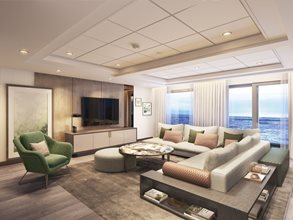
Category: PS
Our Penthouse Suites feature a primary bedroom, bathroom, dining area, guest bedroom and bathroom, terrace, and private hot tub. They even have an attentive butler on hand to ensure you never have to lift a finger during your vacation.- 1-2 bedrooms
- 2 bathrooms
- 1,291-1,432 sq.ft interior / 197-1,098 sq.ft terrace
Highlights
- Spacious layout with a dining table that seats eight and separate sitting area
- Two bedrooms on Edge® Series ships, one bedroom on other ships, and two full bathrooms
- Exclusive eXhale® bedding, featuring king-sized mattresses*
- Veranda with lounge seating
- Private whirlpool tub with views
- Marble primary bathroom with whirlpool tub and dual sinks
- Walk-in closet with generous storage space
Exclusive services and amenities
- Contact your butler wherever you are with Butler Chat
- Destination Experience Specialist to assist with your excursions
- Suite-to-car escort by your butler for Private Journeys
- Shore excursion departure lounge just for suite guests
- Premium Celebrity bath amenities
- Updated Luminae menu with new Daniel Boulud signature dishes
- Complimentary Extend Your Stay program*
- Complimentary access to SEA Thermal Suite and Persian Garden
- Complimentary daily laundry and unlimited pressing
- Personalize your complimentary minibar
- Exclusive sleepwear
- Complimentary specialty dining, including lunch

Category: W
This category can be booked for a special rate, guaranteed to you. Please note that the category is not associated at the time of booking with a specific stateroom, deck, bedding configuration or other particular settings. The assignment of an actual cabin will be performed during your check-in. The cabin can be anywhere on the ship.

| Symbol | Description |
|---|---|
 | Wheelchair-accessible stateroom featuring roll-in shower |
 | Convertible sofa bed |
 | Two upper berths |
 | One upper berth |
 | Connecting staterooms |
 | Inside stateroom door location |
 | Partially obstructed view |
 | Stateroom for occupancy 5 and up |
 | Double convertible sofa bed |
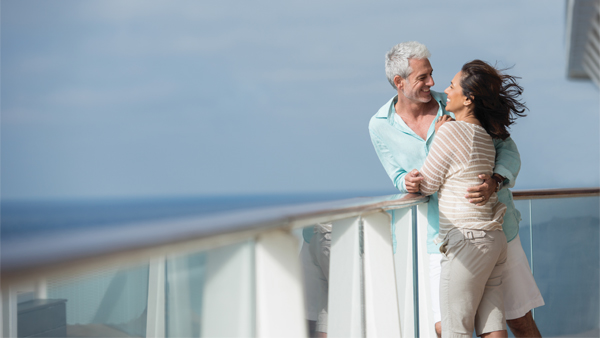
- Ship Name: Celebrity Equinox
- Year Built: 2009
- Year Refurbished: 2019
- Year Entered Present Fleet: 2009
- Ship Class: Solstice
- Maximum Capacity: 3,148
- Number of Passenger Decks: 13
- Number of Crew: 1,246
- Officers' Nationality: Greek
- Ocean-View without Balcony: 70
- Ocean-View with Balcony: 1,150
- Total Inside Staterooms: 148
- Tonnage (GRT): 122,000
- Capacity Based on Double Occupancy: 2,880
- Country of Registry: Malta
- Total Staterooms: 1,440
- Suites with Balcony: 72
- Crew/Hotel Staff Nationality: International
Costco Member Reviews

Available Dates & Prices
Terms & Conditions
*Price shown is per person based on double occupancy and is valid for select stateroom categories only. Click on the Terms & Conditions link below for details.
†One Digital Costco Shop Card per room/stateroom, per stay. The exact amount of the Digital Costco Shop Card will be calculated during the booking process. The Digital Costco Shop Card promotion is nontransferable and may not be combined with any other promotion. A Digital Costco Shop Card will arrive by email approximately 10 days after the start of your cruise. Click on the Terms & Conditions link below for additional information.
Ship's registry: Malta
Digital Costco Shop Card















